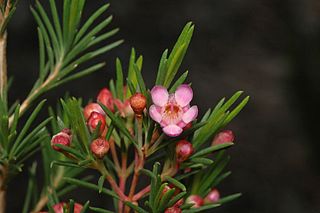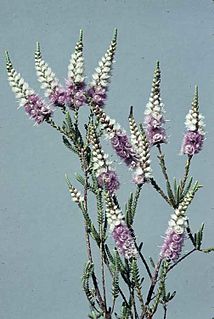
Verticordia apecta, commonly known as scruffy verticordia or Hay River featherflower, is a flowering plant in the myrtle family, Myrtaceae and is endemic to the south-west of Western Australia. It is a slender shrub with linear lower stem leaves, narrow elliptic upper stem leaves and elliptic to egg-shaped leaves near the flowers. There are only a few flowers in the upper leaf axils on relatively long stalks and the sepals are deep pink with fine, white fringes.
Verticordia brachypoda is a flowering plant in the myrtle family, Myrtaceae and is endemic to the south-west of Western Australia. It is an irregularly branched shrub with narrow leaves crowded on side-branches, and cream-coloured or white flowers with pink, cream or white centres.

Verticordia cunninghamii, commonly known as tree featherflower or liandu, is a flowering plant in the myrtle family, Myrtaceae and is endemic to an area in the extreme north of Western Australia and the Northern Territory. It is a spindly shrub or small tree with narrow leaves and cream to white, sweetly scented, feathery flowers.
Verticordia harveyi, commonly known as autumn featherflower, is a flowering plant in the myrtle family, Myrtaceae and is endemic to the south-west of Western Australia. It is a slender, spindly shrub with relatively long leaves and small white, pink or magenta-coloured flowers in late summer and autumn.

Verticordia helichrysantha, commonly known as coast featherflower or Barrens featherflower, is a flowering plant in the myrtle family, Myrtaceae and is endemic to the south-west of Western Australia. It is a small, woody, open-branched shrub with crowded, linear leaves and small yellow flowers from May to September.

Verticordia monadelpha is a flowering plant in the myrtle family Myrtaceae, and is endemic to the south-west of Western Australia. It is a much-branched shrub with pink to magenta flowers in spring and early summer. It is commonly known as pink Morrison, woolly featherflower, pink woolly featherflower, white woolly featherflower or pink cauliflower.

Verticordia spicata, commonly known as spiked featherflower, is a flowering plant in the myrtle family, Myrtaceae and is endemic to the south-west of Western Australia. It is usually a dense, bushy shrub with small leaves pressed against the stem and spikes of pink flowers from late spring to early summer.

Verticordia picta, commonly known as painted featherflower or china cups, is a flowering plant in the myrtle family, Myrtaceae and is endemic to the south-west of Western Australia. It is a small to medium sized shrub with pink and cupped flowers that are sweetly scented.

Verticordia fastigiata, commonly known as mouse featherflower, is a flowering plant in the myrtle family, Myrtaceae and is endemic to the south-west of Western Australia. It is a prostrate or low shrub with small, club-shaped leaves and mouse-scented flowers which vary in colour from golden-yellow and orange to dark red.
Verticordia densiflora var. cespitosa is a flowering plant in the myrtle family, Myrtaceae and is endemic to the south-west of Western Australia. It is a shrub with small leaves and pink, or pink and white flowers. It is one of five varieties of the species Verticordia densiflora.
Verticordia densiflora var. pedunculata, commonly known as long-stalked featherflower, is a flowering plant in the myrtle family, Myrtaceae and is endemic to the south-west of Western Australia. It is a shrub with small leaves and mauve-pink flowers which fade to white. It is one of five varieties of the species Verticordia densiflora and is distinguished from the others by its much longer flower stalks.

Verticordia fimbrilepis, commonly known as shy featherflower, is a flowering plant in the myrtle family, Myrtaceae and is endemic to the south-west of Western Australia. It is a small, bushy shrub with one openly branched main stem at its base, small, pointed leaves and rounded groups of pink flowers near the ends of the branches.

Verticordia fimbrilepis subsp. fimbrilepis is a flowering plant in the myrtle family, Myrtaceae and is endemic to the south-west of Western Australia. It is a small bushy shrub with one openly branched main stem at its base, small, pointed leaves and rounded groups of pink flowers near the ends of the branches.
Verticordia fimbrilepis subsp. australis, commonly known as southern shy featherflower is a flowering plant in the myrtle family, Myrtaceae and is endemic to the south-west of Western Australia. It is a slender shrub with one openly branched main stem at its base, small, pointed leaves and rounded groups of pink flowers near the ends of the branches.
Verticordia huegelii var. stylosa, commonly known as variegated featherflower, is a flowering plant in the myrtle family, Myrtaceae and is endemic to the south-west of Western Australia. It is a single-stemmed shrub with its growth form depending on its surroundings. It is similar to other varieties of the species but differs in its flower colour and the form of the style and staminodes.
Verticordia multiflora is a flowering plant in the myrtle family, Myrtaceae and is endemic to the south-west of Western Australia. It is a small, openly branched shrub with small leaves and groups of scented, bright yellow flowers on the ends of the branches in spring or early summer.

Verticordia oxylepis, commonly known as bonsai featherflower, is a flowering plant in the myrtle family, Myrtaceae and is endemic to the south-west of Western Australia. It is a small shrub, often with a layered appearance, small leaves and very small yellow and pink flowers.

Verticordia tumida, commonly known as summer featherflower, is a flowering plant in the myrtle family, Myrtaceae and is endemic to the north-west of Western Australia. It is an open shrub with very small leaves and clusters of deep pink flowers from late spring to early winter.
Pultenaea adunca is a species of flowering plant in the family Fabaceae and is endemic to the south of Western Australia. It is an erect, spindly shrub with hairy, needle-shaped leaves and yellow and red flowers.
Pultenaea brachyphylla is a species of flowering plant in the family Fabaceae and is endemic to the south of Western Australia. It is an erect, spindly shrub with cylindrical, grooved leaves and yellow, orange and brown flowers.










